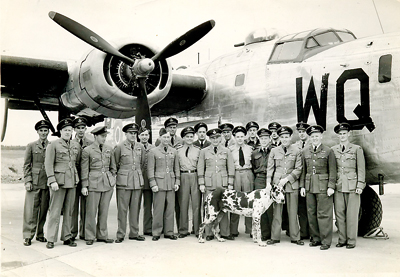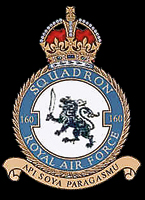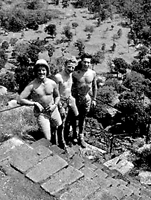A salute to 160 Squadron
View(s):With its one-time base in Sigiriya and Sinhala motto Api soya paragasamu (“We seek and strike”) this particular RAF unit had a special association with the island, says Richard Boyle
Awareness of the Japanese aerial attack on Colombo harbour in April 1942 and the heroics of the pilots of the outnumbered Royal Air Force (RAF) Hurricane fighters lingers, as does the subsequent attack on Trincomalee with the loss of the aircraft carrier HMS Hermes. Less-known, however, is the quite different role played by the RAF in Ceylon during the remainder of the Second World War when the Japanese threat was tenuously contained in Burma and further east.
Bombing, mine-laying, reconnaissance, and later the dropping of supplies to units operating behind enemy lines, were the main duties, often carried out by No. 160 Squadron, which spent three of its four-year lifespan stationed in Ceylon. Indeed, such was the influence of the island on the squadron that the motto chosen was the Sinhala Api soya paragasamu (“We seek and strike”) and the insignia was no less than Lanka’s lion rampant. Thus, among the varied RAF squadrons stationed in Ceylon during the war and its aftermath, No. 160 has an especial association with the island.

Flying instructors (courtesy F/Lt. Mullins)
No. 160 Squadron, part of No. 222 Group RAF, South East Asia Command (SEAC), was equipped with the American-built Consolidated B-24 Liberator, a slab-sided (“The Flying Boxcar”) four-engine heavy bomber, carrying a crew of 11. During the war, 18,400 were constructed, more than any other American aircraft. The British employed over 2,000. Compared with the better-known Boeing B-17 Flying Fortress, the B-24’s design was more modern; the aircraft had a higher speed, greater range, and a heavier bomb-load. However, it was more difficult to fly: popular opinion among aircrews tended to favour the B-17’s robust qualities, especially in the European bombing campaign.
The B-24 was vulnerable. For instance the fuel tanks were placed throughout the upper fuselage, and construction was lightweight in order to increase range, so the aircraft often suffered severe damage in air combat. The B-24 was notorious for its inclination to catch fire. Moreover, its high fuselage-mounted and slender “Davis wing”, which provided greater speed, made it dangerous to belly land since the fuselage tended to break apart. The aircraft was disparaged as “The Flying Coffin” because the only entry and exit was at the rear and it was almost impossible to get from the flight deck to the rear when wearing a parachute.
No. 160 Squadron was formed at the newly-created RAF station at Thurleigh, Bedfordshire, on January 16, 1942. The ground personnel left for the Far East on February 12, while the aircrews remained in the UK for training. The shift eastwards began in early June when the Liberators flew to Palestine. Although supposed to fly on to India, they were retained to execute night raids on targets in Libya and Crete. They also supported Operation Vigorous in June 1942, whose purpose was to provide protection for a convoy from Alexandria to Malta. Some of the squadron’s aircraft were involved in an attack on the Italian fleet at sea during this operation.
It was only after the second battle of El Alamein (October-November, 1942) that the Liberators of 160 Squadron finally flew to India. The first British Liberator squadron to reach the subcontinent, it was used for general reconnaissance from February 1943. However, a few weeks after commencing operations most of the squadron’s aircraft moved to Ceylon, where they flew a mix of shipping protection and long-range photo-reconnaissance missions over Sumatra and the Nicobar Islands.
Ratmalana
From February 19 to August 2, 1943, 160 Squadron was based at RAF Ratmalana with a detachment at RAF Sigiriya. On July 15, 1943, “Received two more Libs (eleven kites now) . . . July 16 Lib and Hurricanes [these fighters and other combat aircraft were also stationed at Ratmalana] practise combat. One Hurricane collided with Lib and landed in lake. Pilot OK,” wrote Corporal Robert Coates in his diary. Must assume the lake referred to was Bolgoda. (A month earlier another Hurricane had crashed near Ratmalana after a dive from 8,000 ft.)
Sigiriya
From August 2, 1943 to July 31, 1944, 160 Squadron was based at Sigiriya with detachments at Ratmalana and RAF Vavuniya. What a unique location for an airfield, so close to such an imposing topographical feature with its spiritual and dramatic associations. What countless varied aerial views of the rock and gardens (although the latter had not then been conserved) the aircrews must have experienced, encouraging many personnel to make the ascent.

Insignia with Sinhala motto and Lion rampant
During the Sigiriya period seven Liberators and many crews were lost. On August 24, 1943, the first plane went missing near the Andaman Islands. According to official records, “This was the first aircraft and crew [of 11] lost by the Squadron in Ceylon . . . it is considered probable that the aircraft entered dangerous clouds at a height where the turbulence was especially violent, and the aircraft got out of control”.
The second aircraft, on a photo-reconnaissance mission, was shot down by Japanese fighters over Car Nicobar, the northernmost of the Nicobar Islands, on September 22, 1943, but not before the turret gunners dispatched one of the attackers. Liberators were equipped like most heavy bombers with a ball turret, a plexiglass dome in the belly of the plane, the most dangerous turret for a gunner who was strapped in upside down. (The ball turret of the Liberator could be retracted into the fuselage when not in use, a necessity given the aircraft’s low ground clearance.)
There is a video of an American Liberator sortie in the Pacific that includes chilling footage of an aircraft losing a wing to enemy fire before spiralling earthwards (http://www.youtube.com/watch?v=lioRCye2Dug).
In 1945, Randall Jarrell published a five-line poem titled “The Death of the Ball Turret Gunner”:
From my mother’s sleep I fell into
the State,
And I hunched in its belly till my
wet fur froze.
Six miles from earth, loosed from its
dream of life,
I woke to black flak and the
nightmare fighters.
When I died they washed me out of
the turret with a hose.
The third aircraft, with a crew of eight, was also lost over Car Nicobar on October 26, 1943. “It is believed that the Japanese now have a small number of fighters which they operate from the Car Nicobar landing ground, with an adjacent radar station whose range is believed to be in the neighbourhood of 100 miles. It is presumed the aircraft was intercepted by enemy fighters.”
On December 7, 1943, a fourth Liberator crashed at Sigiriya. “Normal take-off and circuit, but while on downwind leg, the aircraft suddenly dropped its nose and from about 1,000 feet did an almost vertical spin into the ground. It appeared to level out at the last moment, but crashed through a paddy field into a hill.” The aircraft was burnt out and all the depth charges exploded. Eight crew members were killed.
The beginning of April 1944 found “the station and the squadron with their own radio concerts and programmes relayed every night from their own station studio. The programmes include classical concerts, talks by personnel on their peacetime jobs, quizzes, and a nightly news flash and weekly commentary on the war. On the whole interest is growing.”
Nevertheless, the reality of war was omnipresent, for on April 19, 1944, another Liberator was lost. “Shortly after take-off the aircraft lost height and swinging to port, a propeller struck the A/A gun site near the end of the runway and the aircraft crashed into low trees about 100 yards away.” Corporal Coates wrote in his diary: “Heard ‘B’ crash during the night. Ammunition going off. Squadron Leader Percival and five others lost their lives. Three survivors.”

Ascending Sigiriya (courtesy Jack Fudge)
The sixth aircraft was damaged by its depth charges (they air-fired) and ditched off Puttalam on May 6, 1944. Two crew members were saved but 11 were killed including two from the army. A document at the Public Records Office, Kew, titled “Ditching of a Liberator“, concerns the fate of the aircraft in question:
“At 1710 hours on May 6, 1944, a Liberator was engaged in a depth charge dropping exercise 30 miles west of Puttalam.
The weather was good and sea moderate. After dropping a smoke float as a target, the aircraft turned and ran in at 50 feet. Two depth charges were released and almost immediately afterwards two explosions were heard.
The nose of the aircraft was flung violently upwards and the combined efforts of both pilots were required to right the aircraft. The captain shouted to the wireless operator, who managed to switch on his transmitter and send S.O.S. This signal, in a corrupt form, was picked up by RAF Station, Ratmalana.”
Only the captain and the wireless operator survived the aftermath of the ditching. They had to swim as the emergency dingy was damaged. “A Walrus, one Harvard and two Wildcat aircraft searched an area up to 20 miles west of Puttalam before darkness set in, but saw no signs of wreckage or survivors. Launches had been sent from Colombo, one at 1900 hours and the other at 2225 hours.
On the morning of May 7, the Air Sea Rescue Walrus at Ratmalana was ordered to search the area. Two flights, each of six Beaufort aircraft, were ordered to search an area 3,600 square miles in extent around the search position.
“At about 1120 hours on May 7, the Pinnace which was searching the southern portion of the area, found an ‘H’ type dinghy, which was picked up. It was not until an hour later that two survivors wearing Mae Wests were sighted; one of them frantically waving his underpants.”
On May 17, Lord Louis Mountbatten, Viceroy of India and Commander-in-Chief of SEAC, flew to Sigiriya to give a talk to the squadron. He travelled in an Avro York, a British transport aircraft based on the iconic Avro Lancaster heavy bomber, which had been fitted out as his flying office. Winston Churchill also had a custom-built York that could be used as a flying conference room.
A tragedy not connected to hostilities occurred on May 23, when airman Tom Haynes went missing in the nearby jungle. “The possibility that he has lost his memory causes a careful search. Enquiries are made from all village headmen. Numerous stories come in but investigations lead to no result.” On September 10 his skeleton “was found between Sigiriya Rock and Bear Rock”.
The seventh and final aircraft lost at Sigiriya stalled and crashed 3.5 miles south-west of the airstrip near Habarana on June 15, 1944. The engines were heard screaming at high pitch. “After gaining a height of some 600 feet [the aircraft] lost height on turning and crashed into the jungle at 2354 hours. Aircraft completely burnt out, depth charges explode and the whole of the crew [of eight] killed instantly.”
Just ten years after 160 Squadron shifted from Sigiriya in August 1944 a feature film, The Purple Plain, concerning the Second World War, was shot almost entirely on location in Ceylon, mostly at RAF Sigiriya. Directed by Robert Parrish, the film, set in Burma, is based on the novel of the same name published in 1947 by H.E. Bates. Gregory Peck plays a Canadian pilot serving in the RAF, who flies a Mosquito, mostly made of wood, one of the war’s most remarkable planes (they were stationed in Ceylon).
It must not be forgotten that many RAF squadrons included an array of cosmopolitan pilots and crew. The Purple Plain reflects the fact that apart from 510 Britons, 60 Canadians served in 160 Squadron at this juncture, alongside 43 Australians and four New Zealanders.
Kankesanthurai
From August 1, 1944 to February 7, 1945, 160 Squadron was based at RAF Kankesanthurai, referred to then as now as “KKS”, with detachments at RAF China Bay and RAF Addu Atoll. During this six-month period, hampered by the monsoon, multiple ant-submarine “hunt to exhaustion” sorties were flown, many of them uneventful.
There were exceptions. On October 28, “Information had been received that Japanese short-range submarines were leaving Malaya to drop Indian agents on the east coast of India.” Four Liberators were sent to sweep the area and a submarine was encountered on the surface. Six depth charges were dropped, three of which were thought to have struck the submarine, for it immediately sank leaving “a large circle of bubbling oily water”.
One exercise involved Spitfires of 136 Squadron carrying out a mock shoot-up of the airfield. “This is to be a regular occurrence every Saturday morning. Some good flying was seen.” However, “One disadvantage is that all native labour employed on the airfield cease to work for the whole period.”
F/Lt. L. Parsons committed suicide on November 3: “It is believed that he died of his own hand under the influence of mental depression. The body which was found in an abandoned Hindu temple in the camp perimeter had been there for some time, probably over 12 hours.”
In contrast, on November 8, “A big attraction was the opening of a station cinema using films from the Ceylon cinema circuit. The first picture shown was Ice-Capades [1941: directed by Joseph Shantly]. This show should keep everyone more cheerful during the monsoon.”
Minneriya
From February 7, 1945, to October 17 the same year, 160 Squadron was based at RAF Minneriya. Nearly 1,000 mines were dropped in the early months of 1945. Some of these mine-laying missions were very lengthy – the longest, to Singapore, lasted for 21 hours. Indeed, on March 17 a Liberator made the longest mine-laying operation of the war – 3,600 miles.
One Liberator was lost when on March 20, 1945; it “ran out of fuel and ditched 50 miles off Trincomalee”. Captain S. D. Turner reported (Public Records Office, Kew): “We ditched a mile ahead of a merchant vessel and an hour later the whole aircraft crew was aboard the Dutch MV Tubian. Six of the crew of eight had little trouble in getting out of the aircraft.
The seventh member, P/O J. H. Dorsey, was caught up among aircraft control cables and failed to make his way up through the hole and into the aircraft. Finally, he noticed daylight shining under the aircraft and managed to swim from under the aircraft to the surface.
“Sgt. H. Grundy, the Flight Engineer, was trapped in the back of the aircraft which was slowly sinking. He had a broken hip and a gash across his face. He was calling for help and was handed a knife with which he cut himself free. The rest of us got the dinghies into operation and paddled around picking everybody up until eventually the eight of us were in the two dinghies awaiting the lifeboat from the merchant ship.”
The squadron was transferred to Special Duties in June 1945, dropping agents and supplies to resistance groups in Malaya and Sumatra. Some of these sorties were even longer, lasting for more than 24 hours, a remarkable feat of endurance for the Liberators and their crews.
On June 9, soon after take-off, a Liberator on the way to the Cocos Islands on detachment requested an emergency landing due to an engine failure. “The aircraft was seen approaching from a south-westerly direction at approx. 1,000 feet. When four to five miles from the airfield, aircraft commenced a turn to port and dived steeply into dense jungle.” All 19 on board died (nine were ground crew).
Despite such grim accidents, entertainment was always sought after. “At Minneriya, some of the lads went to the nearby village of Hinkuragoda and bought toddy and arrack which was put into Navy Rum stone jars (one gallon),” wrote Les Crawley in his diary. “The jars were fitted up with taps and tubing supplied by the Instruments Section, and were then mounted as high as possible alongside the charpoys [light Indian bedsteads] and the ‘incumbents’ drip-fed themselves – a favourite pastime after tiffin.”
In his report for July 1945 the Squadron Leader remarked: “There is a belief that now VE Day [Victory in Europe: May 8, 1945] has passed, there is still too little attention made at home of the war in this theatre. This is evident from the BBC news and the newspapers.”
Kankesanthurai
From October 17, 1945, to June 23, 1946, 160 Squadron returned to Kankesanthurai and served for a while in a transport role after the surrender of Japan on August 15, 1945. Repatriation and demobilization became the prime objective for most personnel.
On June 23, the squadron completed its return to the UK and was based at RAF Leuchars, Scotland, operating as a reconnaissance squadron, re-equipped with the Avro Lancaster, but was disbanded on September 30, 1946, being renumbered No. 120 Squadron.
In remembrance of the British and Allied officers and aircrew of 160 Squadron who lost their lives in Ceylon and the Indian Ocean from February 19, 1943, to June 23, 1946
(Sources:
http://www.rquirk.com/lib160.html
http://www.burmastar.org.uk/160sdrn.htm
http://www.davidcbloomfield.co.uk/squadrons/141_160.htm)
Follow @timesonlinelk
comments powered by Disqus





















